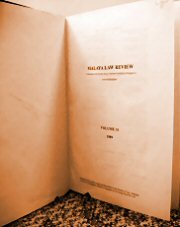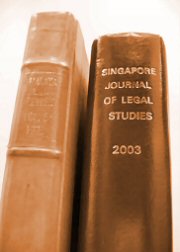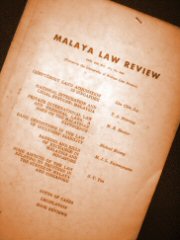|
Archive |
2386 records match your query:
| 331. | JULY 2012 Issue | p.205 | |
| | Book Review: One Nation Under Surveillance: A New Social Contract to Defend Freedom Without Sacrificing Liberty
Eugene K.B. Tan • [2012] Sing JLS 205 (Jul)Institutional efforts to deal with the terrorism threat are in essence a collective action challenge: How do societies prevent terrorist ideology from establishing and gaining traction within a community? Assuming a terrorist attack takes place, especially by "home-grown" terrorists, what can society do to cope with the aftermath? How can societies fortify themselves to come out resiliently against such forces that seek to divide and destroy? These questions perhaps mask the central questions and concerns surrounding surveillance and intelligence - not just what is collected and processed but also how this information is used - in many jurisdictions. Surveillance and intelligence are integral parts of the larger strategy employed to ensure that societies can come out on top of the collective action challenge posed by terrorism.
| | 332. | DECEMBER 2011 Issue | p.309 | |
| | Product Due Diligence and the Suitability of Minibonds: Taking the Benefit of Hindsight
Christopher Chen Chao-hung • [2011] Sing JLS 309 (Dec)This article focuses on some problems arising from applying the product due diligence requirement of the suitability rule to complex financial products. The article draws several conclusions. First, the 'not unsuitable' test should be adopted to reduce legal uncertainty. Second, the comparative risk approach is a better choice in assessing the suitability of investment products. However, there must be further elaboration of the classification of product risk. Third, there must be a balance between risk and return to avoid risk mismatches in product design. Fourth, what have been termed minibonds raise the problem of documentation suitability. Though it is difficult to define suitable documentation, it may be worthwhile for regulators to establish some minimum standards that might have a great influence on product risk. Financial regulators may consider differentiating between financial products in assessing their suitability rather than adopting a one-size-fits-all approach.
| | 333. | DECEMBER 2011 Issue | p.330 | |
| | Causing Loss by Unlawful Means
Lee Pey Woan • [2011] Sing JLS 330 (Dec)In the past, a number of English authorities have suggested that unlawful interference with trade (now also known as "causing loss by unlawful means" is a "genus" tort that provides the rationale as well as framework for analysing various economic torts including intimidation and conspiracy by unlawful means. However, this view has been decidedly rejected by the House of Lords in OBG Ltd. v. Allan. The majority judges in that case restricted the tort to one that redresses only unjustified interferences with third-party liberty. Since it has a multi-party structure, it is conceptually distinct from cases where liability has been imposed for direct (two-party) interferences. On this view, two-party intimidation, unlawful means conspiracy and causing loss by unlawful means are separate torts despite their common reliance on an independent legal wrong. It also means that there is no single thread that runs through this "family" of economic torts. While the element of illegality is an essential and common constituent of these torts, it is not the sole element that justifies the tort. Rather, each tort is founded on the combination of a particular course of conduct with the requisite unlawfulness. Consequently (and more controversially), it is now no longer meaningful to identify a single conception of "unlawful means" that is applicable to all these torts. In each case, it is essential to ensure that the illegality constitutes the tort only if it produces the type of conduct that the tort is designed to deter.
| | 334. | DECEMBER 2011 Issue | p.351 | |
| | Seditious in Singapore! Free Speech and the Offence of Promoting Ill-Will and Hostility Between Different Racial Groups
Jaclyn Ling-Chien Neo • [2011] Sing JLS 351 (Dec)In 2005, the archaic laws of sedition were summoned to counteract speech considered offensive to racial and religious groups in Singapore. Under the Sedition Act, it is seditious to, inter alia, promote feelings of ill-will and hostility between different races or classes of the population. In a later case involving religious proselytisation, a Christian couple was charged and convicted of sedition under the same section. This article examines this new phenomenon. It investigates the manner in which these laws have been employed and jurisprudentially developed to restrain speech on race and/or religion in Singapore. The article argues that the current state of the law is highly problematic for its adverse impact on free speech as well as for its conceptual confusions with alternative bases for restraining speech. It contends that failure to extricate the existing conceptual confusions is adverse to free speech and community integration in the long run. A threefold legal framework is proposed to provide clearer guidance on inter-racial and inter-religious interaction within the Singaporean society.
[Full Text]
| | 335. | DECEMBER 2011 Issue | p.373 | |
| | The 'Whom's' in Online Dissemination of Copyright Works: To Whom and by Whom is The Communication Made?
Ng-Loy Wee Loon • [2011] Sing JLS 373 (Dec)The right of 'communication to the public' was introduced into the Singapore Copyright Act in 2004, as part of its implementation of art. 8 of the WIPO Copyright Treaty (the "WCT") 1996. The purpose of this right is clear enough: it is to allow right-holders to control, inter alia, the dissemination of their copyright works via the internet. There is a recent case in Singapore which involved an unauthorised transmission of copyright works via the internet. Yet the right-holder in this case lost in its claim for infringement of its right of 'communication to the public'. This defeat brings into focus the two essential elements of this right: namely, the two 'Whom's'. To whom is the communication made - is it to "the public"? By whom is the communication made - is it the defendant in the infringement action? This article suggests that the Singapore approach in answering these two questions is overly strict, and may be inconsistent with what the promulgators intended for the right of 'communication to the public'. This assessment is made in the light of the travaux pre'paratoires of the WCT, as well as developments in Australia and the EU.
| | 336. | DECEMBER 2011 Issue | p.394 | |
| | Air Pollution in Hong Kong: The Failure of Judicial Review and the Slight Promise of Recent Cases
Rohan Price and John Kong Shan Ho • [2011] Sing JLS 394 (Dec)Public bodies are endowed with far-reaching administrative powers to formulate and implement policy. Administrative law focuses upon the extent of these powers, the way in which they are exercised and controlled, and on the relationship between public bodies and those who are affected by decision-making. With the growth of executive power, judicial review has emerged as a necessary counterweight to assure accountability in the decision-making of government authorities. Against such a background, this article evaluates the contribution which judicial review has made to combating air pollution in Hong Kong to date. It essays a variety of reasons to do with Hong Kong's colonial past as to why judicial review has, in general, been a dilute force for accountability of administrators and especially so when a decision has environmental implications.
| | 337. | DECEMBER 2011 Issue | p.412 | |
| | Focusing on Corporate Short-Termism
Razeen Sappideen • [2011] Sing JLS 412 (Dec)Much concern has been expressed over the problem of 'short-termism' as evidenced in the numerous discussion papers made public by industry and investor associations and regulatory bodies in the US and the UK. While concerns over short-termism and its effects are not new, the short-termism being experienced now is the result of structural changes brought about by agency theory based managerial compensation and its four legged strategy of short term managerial employment contracts, stock based compensation, high stock price, and the pursuit of high-risk high-return investment strategies to achieve the latter. This article investigates the changes to corporate governance structure that have produced short-termism, short-termism's present form and continuing hold, how it has impacted on corporate governance, and what, if anything, should be done about it.
[Full Text]
| | 338. | DECEMBER 2011 Issue | p.432 | |
| | Bondholder Rights and the Section 216 Oppression Remedy
Seah Chi-Ling • [2011] Sing JLS 432 (Dec)Notwithstanding that s. 216 of the Singapore Companies Act, on a literal construction, extends the oppression remedy to debentureholders of a company, there have to date been no reported cases in Singapore involving any attempted use of the oppression remedy by debentureholders. This article first explores the origins of the references to 'debentureholders' in s. 216. This article then proceeds to examine the scope of the s. 216 remedy in a debentureholder context, and concludes by discussing a number of principles upon which a fairness analysis in a debentureholder context may be undertaken.
| | 339. | DECEMBER 2011 Issue | p.456 | |
| | The Reynolds Privilege in a Neo-Confucianist Communitarian Democracy: Reinvigorating Freedom of Political Communication in Singapore
David Tan • [2011] Sing JLS 456 (Dec)This article explores how defamation jurisprudence in Singapore has elevated the political public figure to an exalted position, virtually according the reputation of these honourable men, or junzi, heightened protection over the constitutional guarantee of freedom of speech. It takes the position that there are sufficient bases for the Reynolds v. Times Newspapers Ltd. privilege (the Reynolds privilege) to be adopted under Singapore common law, independent of any reliance on art. 10 of the European Convention on Human Rights. It further argues that courts in Singapore ought to draw on relevant English and Australian jurisprudence, and consider a broader qualified privilege defence in defamation suits involving political public figures. The author concludes that the common law of qualified privilege in Singapore should be reviewed to take into account a multi-factorial approach when examining whether greater leeway may be accorded to citizen comments on public officials and public policy that are relevant to good government and good governance.
| | 340. | DECEMBER 2011 Issue | p.486 | |
| | Taking Stock of the Insolvency Tests in Section 254 of the Companies Act
Wee Meng Seng • [2011] Sing JLS 486 (Dec)The recent Court of Appeal decision in BNP Paribas v. Jurong Shipyard Pte Ltd is a landmark decision on the insolvency tests in s. 254 of the Companies Act. Although the court did not expressly decline to follow English law, various propositions in the judgment mark the beginning of a distinct Singaporean jurisprudence on the meaning of the insolvency tests. This article explains the old law, which is poorly understood due to a lack of discussion, and examines the extent to which that has been altered by BNP.
| |
|
|


 |







